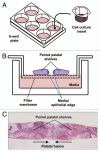Palatogenesis: engineering, pathways and pathologies
- PMID: 21964245
- PMCID: PMC3265826
- DOI: 10.4161/org.7.4.17926
Palatogenesis: engineering, pathways and pathologies
Abstract
Cleft palate represents the second most common birth defect and carries substantial physiologic and social challenges for affected patients, as they often require multiple surgical interventions during their lifetime. A number of genes have been identified to be associated with the cleft palate phenotype, but etiology in the majority of cases remains elusive. In order to better understand cleft palate and both surgical and potential tissue engineering approaches for repair, we have performed an in-depth literature review into cleft palate development in humans and mice, as well as into molecular pathways underlying these pathologic developments. We summarize the multitude of pathways underlying cleft palate development, with the transforming growth factor beta superfamily being the most commonly studied. Furthermore, while the majority of cleft palate studies are performed using a mouse model, studies focusing on tissue engineering have also focused heavily on mouse models. A paucity of human randomized controlled studies exists for cleft palate repair, and so far, tissue engineering approaches are limited. In this review, we discuss the development of the palate, explain the basic science behind normal and pathologic palate development in humans as well as mouse models and elaborate on how these studies may lead to future advances in palatal tissue engineering and cleft palate treatments.
Figures




References
-
- Fraser FC. Thoughts on the etiology of clefts of the palate and lip. Acta Genet Stat Med. 1955;5:358–369. - PubMed
Publication types
MeSH terms
Grants and funding
LinkOut - more resources
Full Text Sources
